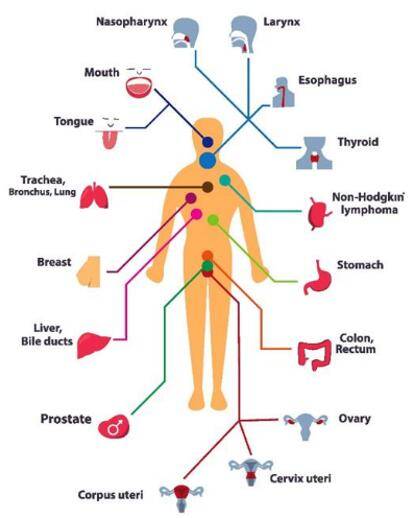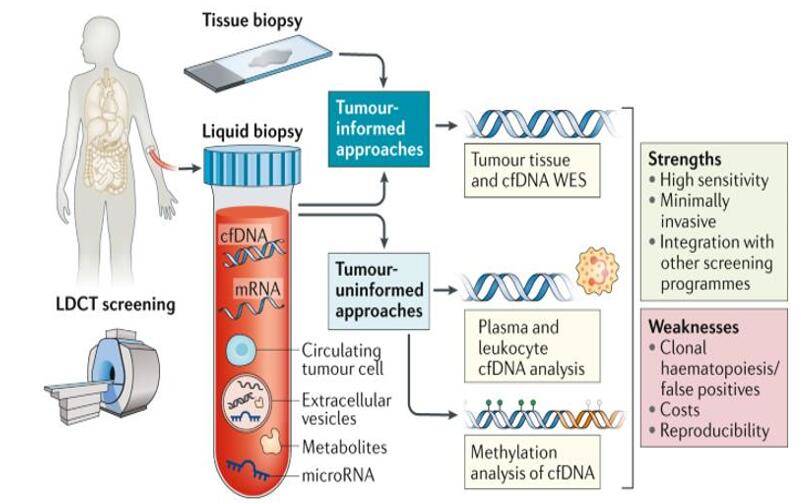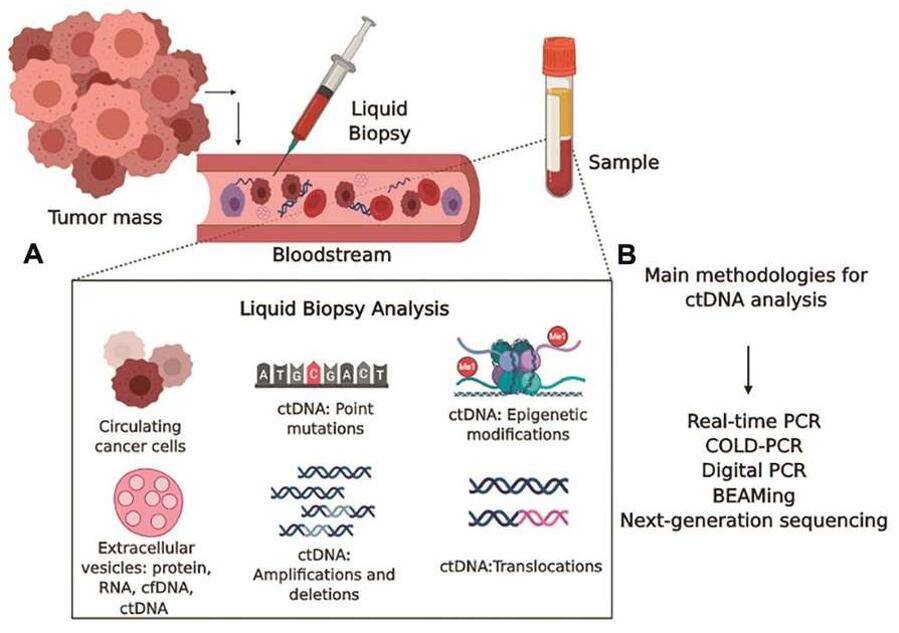The Difference Between cfDNA and ctDNA
Cell-free DNA (cfDNA) refers to the DNA that is liberated into the bloodstream as a result of processes such as apoptosis, necrosis, and secretion. Typically manifesting as double-stranded fragments, cfDNA spans approximately 150-200 base pairs in length.
Circulating tumor DNA (ctDNA), on the other hand, encompasses molecular genetic and epigenetic information mirroring the genome or epigenome of the cell from which it originates.
Please refer to our article Uncovering Drug Resistance in Cancer: Insights from ctDNA Sequencing for more information.

It's important to note that the categorization of DNA into these two types based on origin does not imply a disparity in the fundamental structure of the two.
In healthy adults, the concentration of cell-free DNA (cfDNA) is typically low, usually measuring less than 10 micrograms per milliliter of plasma. Conversely, in cancer patients, specific components of cfDNA are released by tumor cells, constituting what is known as circulating tumor DNA (ctDNA). The proportion of ctDNA within the overall cfDNA background varies significantly, ranging from 0.05% to 90%. Several factors influence ctDNA concentration, including tumor size, localization, hematopoiesis, antitumor therapy (e.g., surgery, chemotherapy, radiotherapy, etc.), and hepatic and renal clearance.
The half-life of ctDNA spans from 16 minutes to 2.5 hours, rendering ctDNA analysis akin to a "real-time snapshot" of a tumor's condition. Remarkably, ctDNA can be detected in nearly 100% of certain cancer types, such as bladder, colorectal, and ovarian cancers, with a greater than 50% probability of detection in most other cancer types. Notably, ctDNA is identified in almost 100% of bladder, colorectal, and ovarian cancers, and has a probability exceeding 50% for detection in the majority of other cancer types, although its detection rate is notably lower at 10% for gliomas. Furthermore, ctDNA plasma concentrations and the presence of detectable ctDNA levels have been demonstrated to correlate with tumor stage.
ctDNA and Liquid Biopsy Techniques
Circulating tumor DNA (ctDNA) encapsulates genetic features linked to tumor cells, encompassing mutations, methylation patterns, insertions, rearrangements, and copy number abnormalities. It emerges as a crucial indicator for tumor screening, companion diagnostics, assessing therapeutic efficacy, and stratifying prognostic risks.
Please refer to our article The Promise of Liquid Biopsy in Disease Detection and Monitoring for more information.
 Liquid biopsy for early stage lung cancer. (Rolfo et al., 2020)
Liquid biopsy for early stage lung cancer. (Rolfo et al., 2020)
The study's findings underscore the ctDNA assay's value as a non-invasive tool that faithfully mirrors gene mutation profiles and frequencies within solid tumor tissues. This assay stands as a pivotal monitoring indicator for evaluating treatment efficacy and conducting post-treatment clinical follow-ups. However, the attainment of detectable ctDNA concentrations in body fluids proves challenging in early asymptomatic individuals. Moreover, ctDNA fragments exhibit a brief half-life, and specific mutations may be exceedingly minute, presenting limitations in early-stage tumor screening.
Advancements in liquid biopsy techniques have facilitated the collection of various body fluids to analyze patients' molecular characteristics. Notably, ctDNA-based high-throughput sequencing, particularly next-generation sequencing (NGS) technology, is gaining widespread clinical usage. This approach is favored for its non-invasive or minimally invasive nature, swift detection capabilities, ability to reflect intratumoral and metastatic foci heterogeneity, and dynamic monitoring of treatment efficacy. The increasing adoption of NGS in clinical practice attests to its advantages in the realm of non-invasive or minimally invasive diagnostic methodologies.
Cutting-edge technologies, such as high-throughput sequencing and long-read sequencing, employed by CD Genomics, facilitate the robust analysis of ctDNA (circulating tumor DNA) and cfDNA (cell-free DNA). This advanced sequencing approach allows for comprehensive and efficient examination of genetic material, providing valuable insights into the molecular landscape and potential biomarkers associated with various conditions.
cfDNA and Cancer Research
Ranging from 50 to 300 base pairs, cfDNA fragments are typically present in low concentrations in the blood of healthy individuals. However, with the progression of cancer and other health conditions, cells release substantial amounts of DNA into circulation, leading to elevated blood levels of cfDNA. For instance, pancreatic cancer patients exhibit shorter cfDNA fragment sizes and higher cfDNA levels compared to healthy controls.
 ctDNA as a Cancer Biomarker (Pessoa L S et al., 2020)
ctDNA as a Cancer Biomarker (Pessoa L S et al., 2020)
Various forms of cfDNA, such as circulating tumor DNA, mitochondrial DNA, and fetal DNA, extracted from human blood, have found extensive application in diagnostics and screenings. These applications span areas like liquid biopsy, early cancer screening, noninvasive prenatal screening (NIPT), medication guidance, and infectious disease diagnosis, supported by a burgeoning body of clinical research.
In the current surge of interest in early cancer screening, cfDNA methylation has taken center stage. Technologies like GRAIL's early cancer screening, embedded in cfDNA methylation, have surpassed the performance of cfDNA mutation and cfDNA genome-wide copy number technologies. Detecting methylation involves treating cfDNA with bisulfite or enzymatically converting cytosine to uracil. However, this method introduces biases, including pronounced GC preference, DNA damage, and PCR amplification bias. Additionally, the low yield of cfDNA extracted from plasma remains a formidable challenge in characterizing the cfDNA methylome of patients using conventional sequencing methods.
References:
- Desai A N, Jere A. Next-Generation Sequencing for Cancer Biomarker Discovery. Next Generation Sequencing in Cancer Research, Volume 2: From Basepairs to Bedsides, 2015: 103-125.
- Pessoa L S, Heringer M, Ferrer V P. ctDNA as a cancer biomarker: A broad overview. Critical reviews in oncology/hematology, 2020, 155: 103109.
- Lever J, Jones M R, Danos A M, et al. Text-mining clinically relevant cancer biomarkers for curation into the CIViC database. Genome medicine, 2019, 11: 1-16.
- Hayes J, Peruzzi P P, Lawler S. MicroRNAs in cancer: biomarkers, functions and therapy. Trends in molecular medicine, 2014, 20(8): 460-469.
- Rolfo, Christian, and Alessandro Russo. "Liquid biopsy for early stage lung cancer moves ever closer." Nature Reviews Clinical Oncology 17.9 (2020): 523-524.


 Sample Submission Guidelines
Sample Submission Guidelines

 Liquid biopsy for early stage lung cancer. (Rolfo et al., 2020)
Liquid biopsy for early stage lung cancer. (Rolfo et al., 2020) ctDNA as a Cancer Biomarker (Pessoa L S et al., 2020)
ctDNA as a Cancer Biomarker (Pessoa L S et al., 2020)